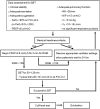Differences in clinical outcomes according to weaning classifications in medical intensive care units
- PMID: 25876004
- PMCID: PMC4398406
- DOI: 10.1371/journal.pone.0122810
Differences in clinical outcomes according to weaning classifications in medical intensive care units
Abstract
Background: Although the weaning classification based on the difficulty and duration of the weaning process has been evaluated in the different type of intensive care units (ICUs), little is known about clinical outcomes and validity among the three groups in medical ICU. The objectives of this study were to evaluate the clinical relevance of weaning classification and its association with hospital mortality in a medical ICU with a protocol-based weaning program.
Methods: All consecutive patients admitted to the medical ICU and requiring mechanical ventilation (MV) for more than 24 hours were prospectively registered and screened for weaning readiness by a standardized weaning program between July 2010 and June 2013. Baseline characteristics and outcomes were compared across weaning classifications.
Results: During the study period, a total of 680 patients were weaned according to the standardized weaning protocol. Of these, 457 (67%) were classified as simple weaning, 136 (20%) as difficult weaning, and 87 (13%) as prolonged weaning. Ventilator-free days within 28 days decreased significantly from simple to difficult to prolonged weaning groups (P < 0.001, test for trends). In addition, reintubation within 48 hours after extubation (P < 0.001) and need for tracheostomy during the weaning process (P < 0.001) increased significantly across weaning groups. Finally, ICU (P < 0.001), post-ICU (P = 0.001), and hospital (P < 0.001) mortalities significantly increased across weaning groups. In a multiple logistic regression model, prolonged weaning but not difficult weaning was still independently associated with ICU (adjusted OR 8.265, 95% CI 3.484-19.605, P < 0.001), and post-ICU (adjusted OR 3.180, 95% CI 1.349-7.497, P = 0.005), and hospital (adjusted OR 5.528, 95% CI 2.801-10.910, P < 0.001) mortalities.
Conclusions: Weaning classification based on the difficulty and duration of the weaning process may provide prognostic information for mechanically ventilated patients who undergo the weaning process.
Conflict of interest statement
Figures


References
-
- Esteban A, Ferguson ND, Meade MO, Frutos-Vivar F, Apezteguia C, Brochard L, et al. Evolution of mechanical ventilation in response to clinical research. Am J Respir Crit Care Med. 2008;177: 170–177. - PubMed
-
- Esteban A, Anzueto A, Frutos F, Alia I, Brochard L, Stewart TE, et al. Characteristics and outcomes in adult patients receiving mechanical ventilation: a 28-day international study. JAMA. 2002;287: 345–355. - PubMed
Publication types
MeSH terms
Substances
LinkOut - more resources
Full Text Sources
Other Literature Sources
Medical

